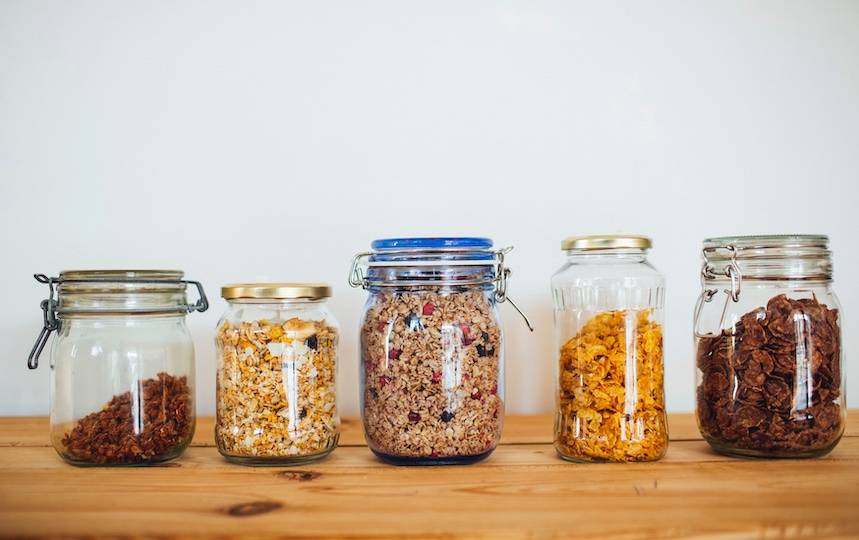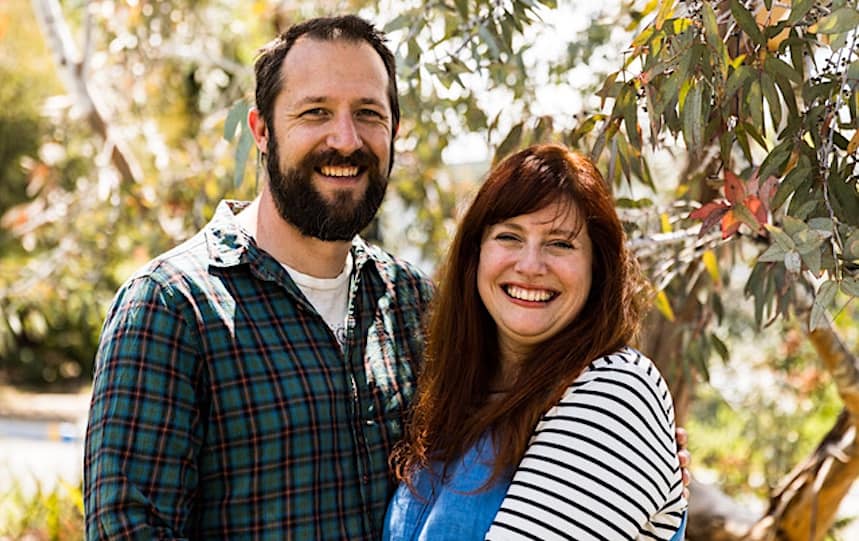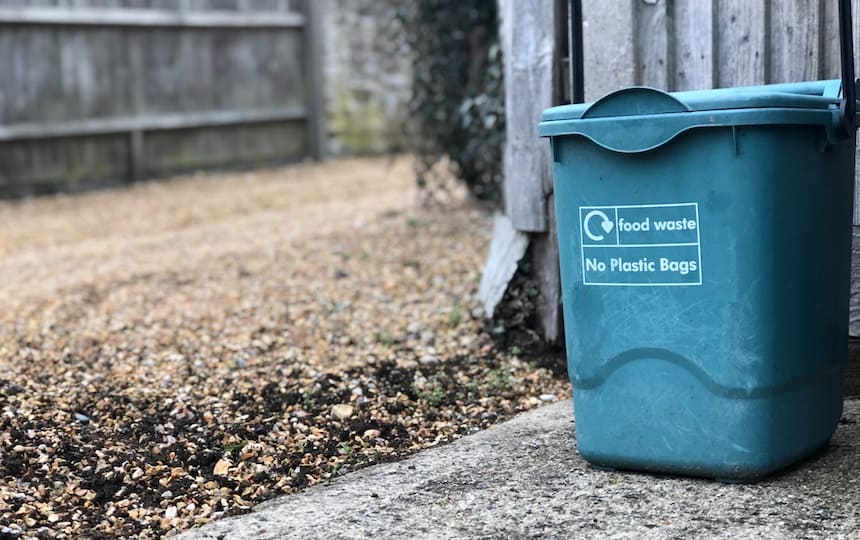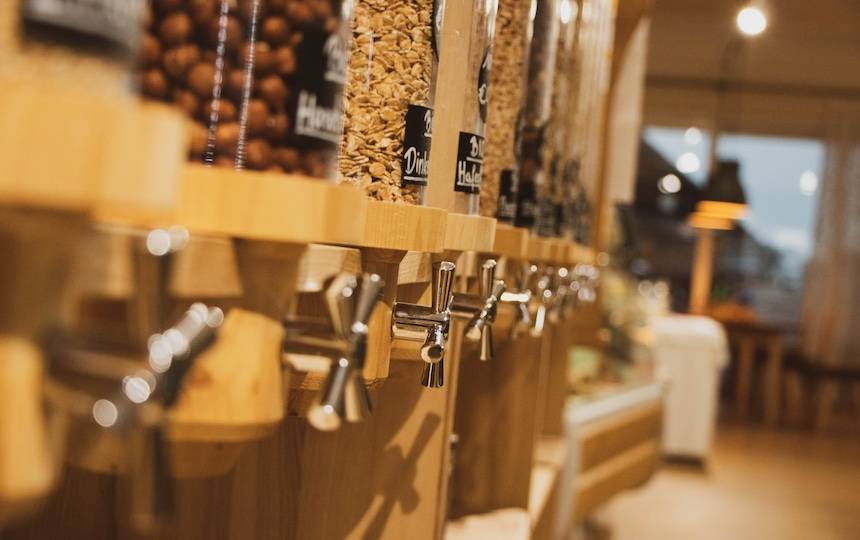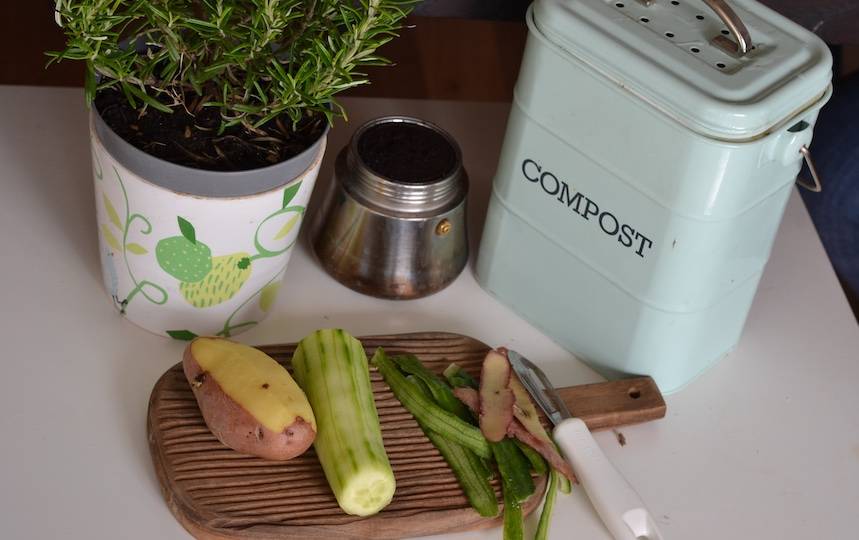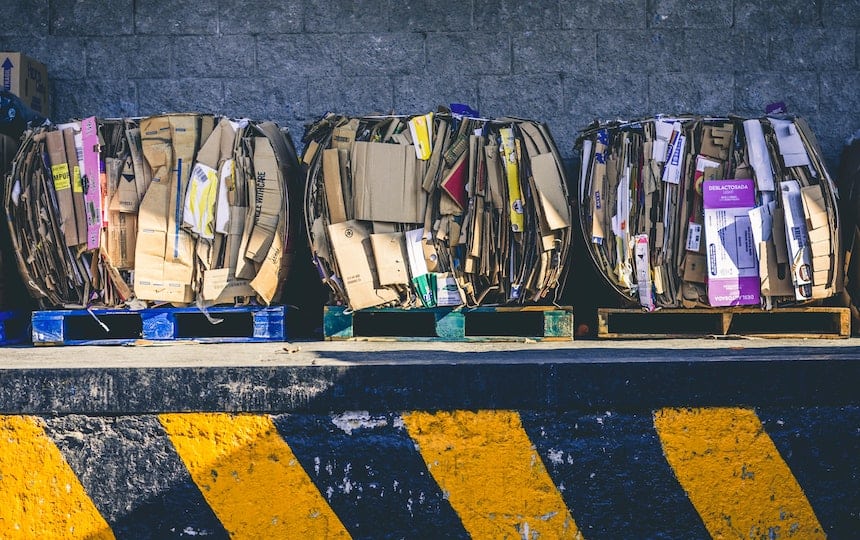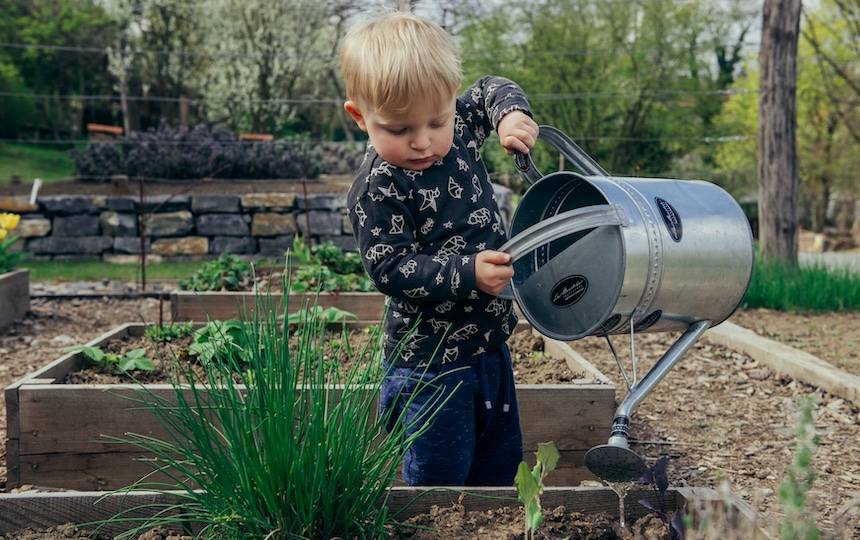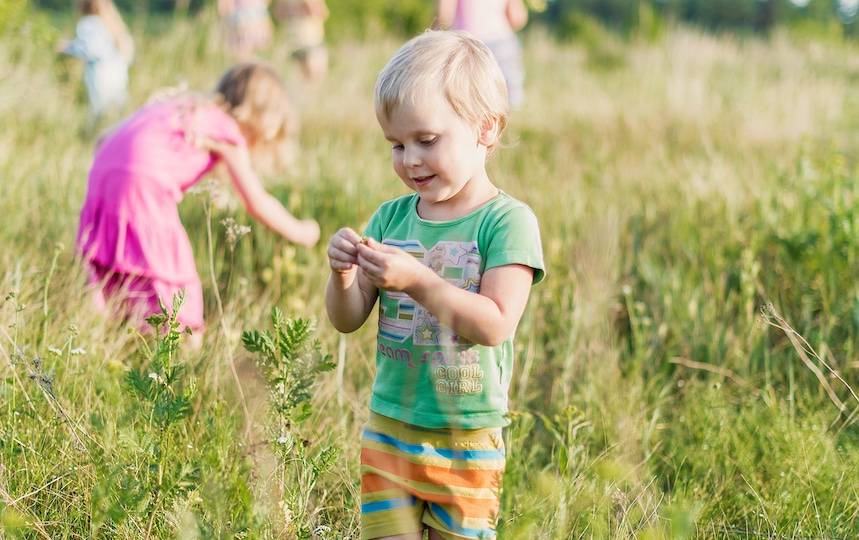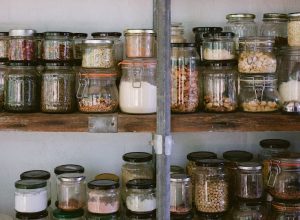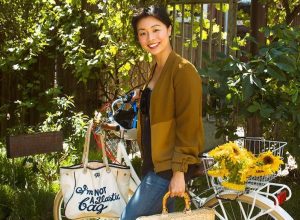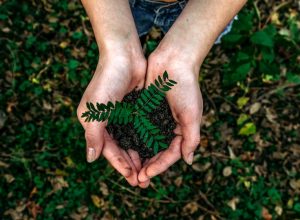Spiral Garden’s Lauren and Oberon Carter answer all your curly questions when it comes to sustainable and zero waste living.
Zero waste living means becoming more mindful about the impact of our everyday habits, that we often don’t even think twice about.
Such as the harmful effects our overconsumption of plastic has on the environment. Or the repercussions of sending our food waste to landfill, which eventually rots and gives off methane gas and contributes to greenhouse gas emissions.
It’s realising that our “small” everyday actions add up to big problems for our planet. And it means asking, “What can I do to help rather than harm?”.
Authors of the fabulous book, ‘A Family Guide to Waste-Free Living’ (Pan Macmillan Australia 2019), Lauren and Oberon Carter are long-time champions of zero waste living and the sustainability movement.
On a simple suburban house block in Tasmania they have built an enviable permaculture designed home and garden, along with their three daughters – who are also keen advocates of sustainability.
They know that zero waste living can sometimes be tricky – especially when you’re just starting out – so Lauren and Oberon spent some time answering some of Pip‘s readers most pressing questions when it comes to living zero waste.
Getting started
I feel a bit overwhelmed with all the information on zero waste. I want to reduce my household’s waste, but I’m not sure where to start. Do I need to buy anything first? (Catherine, Launceston, TAS).
We’ve found a smart way to approach the shift to zero waste living is to work out exactly what waste you’re making. Here’s how to get started:
- Audit your waste by counting it as it goes into the rubbish or recycling bin. That will give you a good starting point to improve upon and help you identify your main streams of waste.
- Food waste makes up around half the average household bin, so we’d recommend eliminating that first.
- Then find ways to access food and products without packaging.
- You don’t need to buy anything to begin with, but some sturdy cloth bags and a few jars can help. You can often find these second-hand or you can make your own cloth and produce bags (check out Issue #10 of Pip).
Food
I went to buy pasta at my local bulk foods shop and it cost much more than I’m used to paying. How can I make zero waste living affordable for my family? Mandy, (Narara, NSW).
One-to-one substitutions (from packaged to package-free) certainly can make zero waste living look like something exclusive to the wealthy. However, in our experience, some things are more expensive package-free, whilst others are cheaper.
Taken as a whole-of-life thing, we make savings because we make lots from scratch, we grow some of our own food, we participate in alternative-economy food systems (eg. swaps with neighbours), we forage food as a recreational pastime, and we buy clothing and many household items second-hand for much less than the price for new.
These frugal, cost-friendly actions allow us to splurge when needed on things like package-free pasta, or bulk chocolate. And of course, you can also make many of the items – like sourdough pasta – from scratch, which will help you save your pennies!
I find it so hard to source dairy without plastic. Any suggestions? (Bec, Geelong, VIC).
We are fortunate to have an organic dairy in Tasmania that provides milk, cream and yoghurt in refillable glass jars and bottles, and cheese without packaging, put straight into our own containers.
But for the first year of us trying to live without waste, that dairy was not operating and so we went completely without cheese for a year! We definitely learned to appreciate the waste free option when it became available.
Other options for plastic-free “dairy” include making your own nut or oat milk; buying butter in paper or foil or, if you can get milk and cream in returnable glass (but not other dairy items), making your own cheese, yoghurt and butter.
It’s worth noting that the primary source of greenhouse gas emissions from dairy comes from processes on the farm (rather than the packaging), so try to favour local farms that operate in ways to keep waste to a minimum.
Packaging
I want to make less waste but I find it hard because there are no good bulk food shops near me. What can I do to reduce my packaging waste? (Anna, Lawnton, QLD).
It can be tricky finding package-free food when you don’t have access to it locally. But there are a few ways you could approach it.
Firstly, look for what you can find nearby. Look for plastic-free produce, and if you have growers near you, ask if you can access their product without packaging.
If you travel to an area with package-free shops semi-regularly, try making the most of the trip and shop at the same time. This might require a little forward thinking, some meal planning, space to store larger quantities of food, and a larger outlay of money initially as you buy enough food to last until your next shop.
Another option is to begin your own bulk food co-op within your local community. There’s work involved in establishing it, but the benefits can include cheaper food, reduced packaging waste, encouraging more households to reduce their waste, and more contact with people in your local community as you work together towards a common goal (you might make new friends).
If we buy our bulk food from local bulk shops, we don’t take home any packaging. What about all the waste produced before something reaches the shops? (Sarah, Ferny Hills, QLD).
Some popular zero waste or waste-free lifestylers tend to focus on reducing rubbish (especially packaging) in the home.
However, it is worth considering the waste that occurs earlier in the supply chain, whether it be from a bulk food store or any shop.
Bulk stores vary in the attention they give to minimising waste. Have a chat to the store owner/manager to learn more about what goes on behind the scenes.
In some cases, a store can be selective and order in products that tend to come with less packaging (or they can weigh up other environmental and social factors). Usually the large bags and containers that bulk shops buy result in less waste compared with the multitude of small bags and containers for supermarket goods.
You can also do a bit of your own research about waste associated with given items, for example, you might Google the impacts of buying overseas nuts versus from a local supply.
I’ve heard my local council might be sending all the recycling I’ve collected for my kerbside bin straight to landfill. Should I still be collecting it? (Fay, Bunbury, WA).
We encourage people to try to reduce the overall quantity of recyclable waste material made in the first place.
It is true that recycling of material into new objects uses less energy than if creating something from virgin materials. However, we have found that in many cases, single-use packaging (whether it be containers made of plastic, glass or metal) are avoidable.
In our household, we have taken a position of trying to take personal responsibility of any waste we produce and that extends to recyclables. We avoid buying food in cans, or recyclable plastic or glass, because we have options available to obtain food without them.
Paper and cardboard is either used to start our wood heater, or goes in the compost or in the garden as sheet mulch. If you do have recyclable material and you’re unsure whether it is being recycled, it is best to ask your local council.
Kids
I’m always wondering how my children would handle living zero waste. Is there a way to make it easy for them to take on? (Chelsea, Anstead, QLD).
When we first approached the shift towards waste-free living, we made a family pact. We included our kids in the discussion, and took them along to help us research our shopping options. They’ve been involved at every step.
We’ve also been honest with them about waste and the positive impact that they can have by learning to live with making much less of it. Kids are pretty intuitive when it comes to talking about the environment and ways to protect it, and generally want to care for it, when options and clear information are provided to them.
Our children say the hardest thing is when their friends offer them things and they need to say no, because they don’t want to make waste. But waste-free living hasn’t been super challenging for them. There are usually options and they’d rather prioritise the environment, and their friends are usually very understanding and want to know more.
We’ve found focusing on what we can have, rather than what we can’t, goes a long way towards feelings of abundance and contentment.
How do you minimise clothing waste, especially with children who constantly grow?! (Jessie, Geeveston, TAS).
When choosing clothing for ourselves and our children, we’re careful to look for natural fibres and fabrics that will compost at the end of their life – fibres like hemp, linen, wool and organic cotton.
We look for quality fabrics and good construction that will last, and we generally avoid fast fashion where we can. Op-shops and tip-shops are a great source of kids clothes, especially as many are inundated with bags of unwanted clothing before it heads to landfill.
We’d also recommend clothing swaps with friends. We’ve been very fortunate to have friends around us who have handed down bags of clothes as their children outgrew them, and we’ve been very happy to pass those same clothes onto friends of ours, so that the same clothing items have gone through many children in our community before finally wearing out.
Mending is another important way to keep clothing from landfill, and making and mending clothes are great skills for kids to learn from an early age.

